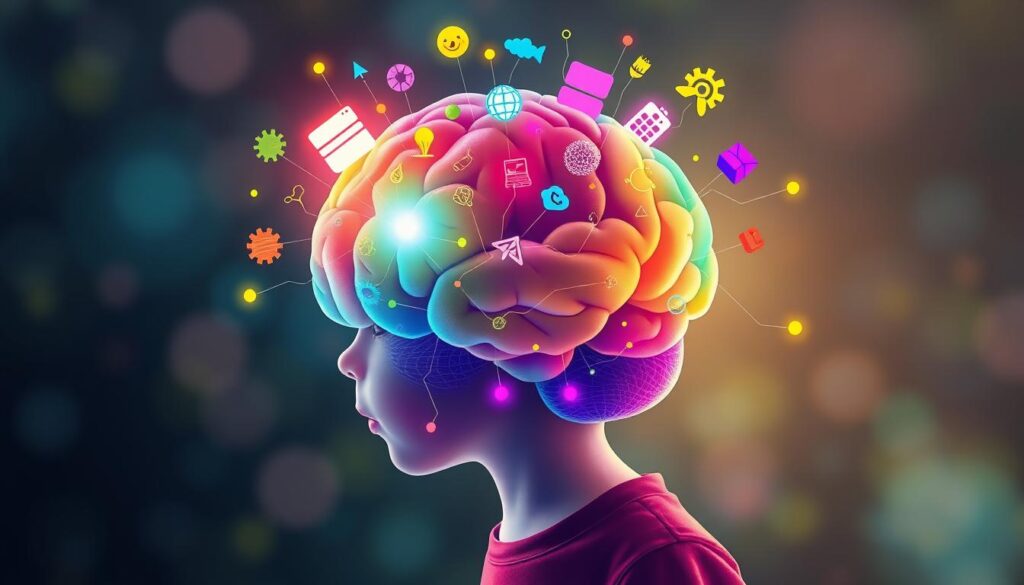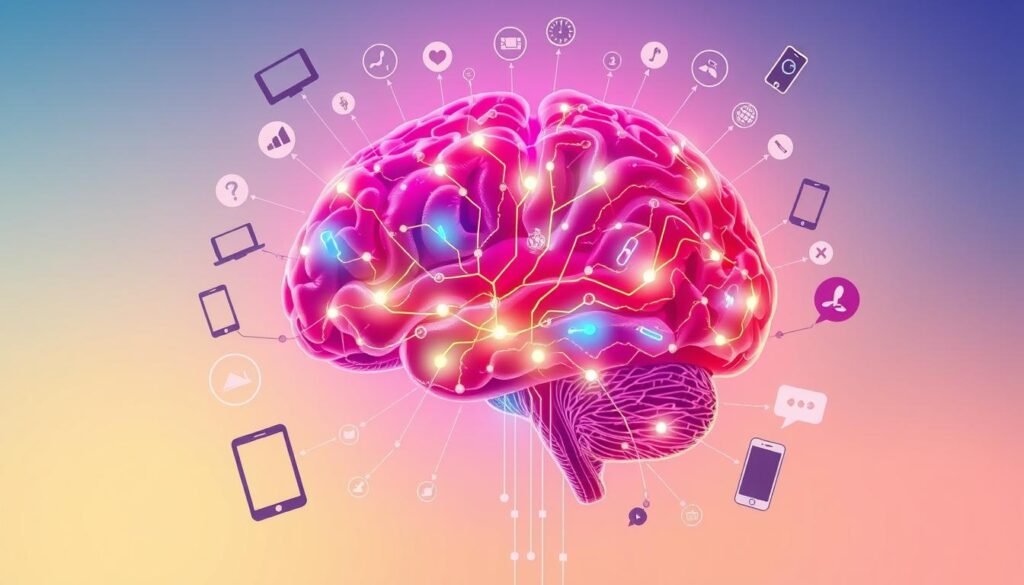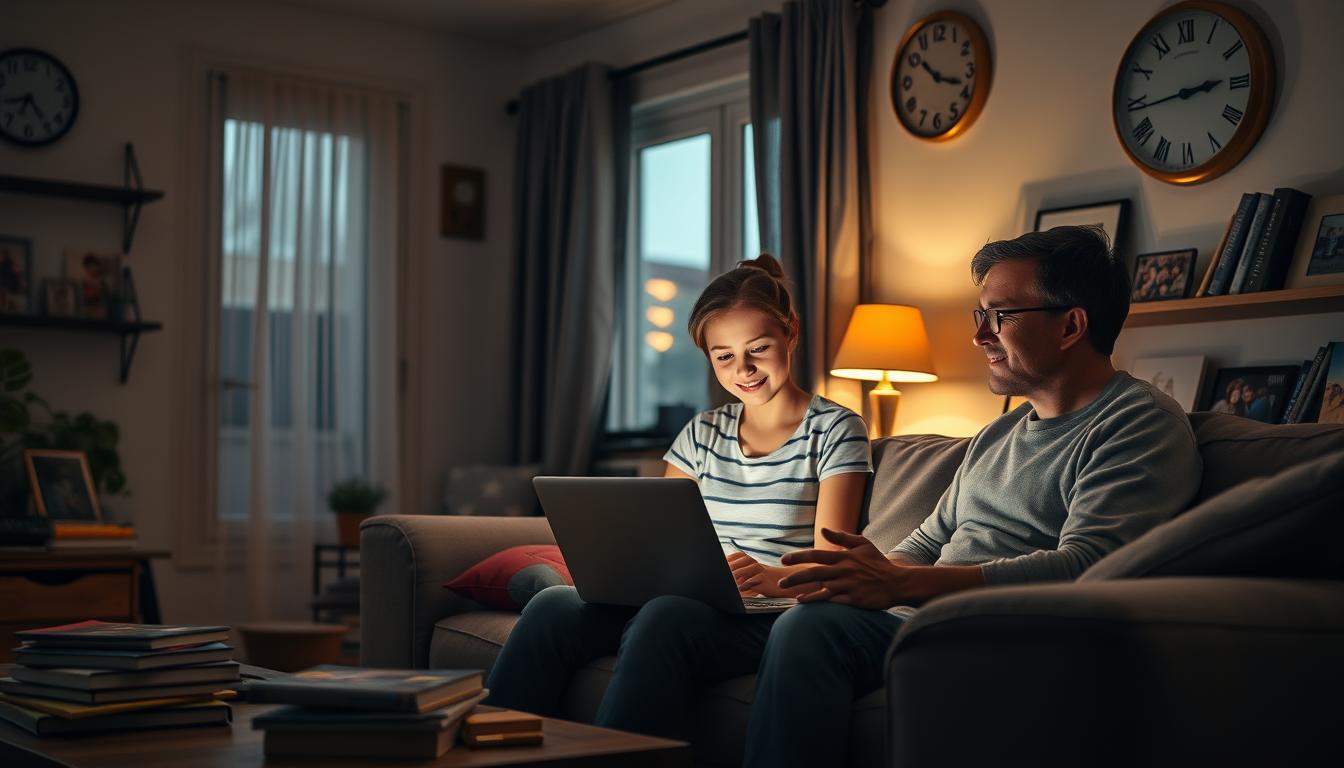As a parent, I worry about how screen time affects my kids’ brains. Today, kids use a lot of digital media like phones, tablets, and TVs. We know tech has changed our lives, but we don’t fully understand its long-term effects on young minds.
I’ve been looking into this topic closely. The research is both interesting and worrying. It shows too much screen time can change how kids’ brains work. This includes their focus, language skills, and how they feel about others. As a parent, I want to know more and find a good balance for my kids.
Key Takeaways
- Too much screen time can really affect young kids’ brains.
- Being on digital media can mess with their focus, language, and feelings.
- It’s key to understand these effects to keep kids healthy and balanced.
- Learning about this helps parents make smart choices about their kids’ screen use.
- It’s important to limit screen time and encourage other activities for kids to grow well-rounded.
Understanding Screen Time in Modern Childhood
In today’s world, screens are a big part of kids’ lives. They watch educational videos and play games on screens. It’s important for parents and teachers to know how much time kids spend on screens.
Digital Media Consumption Patterns
Research shows that kids in the US spend hours a day on digital devices. A lot of this time is spent on fun activities like gaming and social media. This makes us worry about how screens might affect kids’ growth and happiness.
Types of Screen Exposure in Early Years
- Educational apps and educational videos
- Recreational gaming and social media
- Streaming platforms for movies and TV shows
- Video chatting with family and friends
- Internet browsing and online research
Current Screen Time Statistics
| Age Group | Average Daily Screen Time |
|---|---|
| 0-2 years | 42 minutes |
| 3-5 years | 2 hours 24 minutes |
| 6-8 years | 3 hours 6 minutes |
| 9-11 years | 4 hours 36 minutes |
These numbers show how much time kids spend on screens. It makes us think about how screens might affect their brain development, digital wellbeing, and technology addiction.
The Effects of Screen Time on Young Children’s Brain Development
Our digital world is growing fast. It’s key to know how screen time affects young kids’ brains. Many studies have shown both good and bad sides of digital media for kids in their early years.
Screen time can affect attention span. Studies say too much fast-paced digital stuff can make kids less focused. This can hurt their ability to concentrate and do well in school.
On the other hand, brain plasticity is also influenced by screen time. Good digital content can help kids’ brains grow. But, it’s important to use screens wisely to avoid harm.
Screen time also affects language development in young kids. While some apps can help with language, too much screen time can slow it down. This shows we need to use digital media carefully in kids’ early years.
“The first few years of a child’s life are a sensitive period for brain development, and the effects of screen time during this time can have lasting impacts.”
In summary, screen time’s impact on young kids’ brains is complex. Digital media can be good for learning, but we must balance it. We should make sure screen time helps, not hinders, kids’ cognitive development.

Brain Plasticity and Digital Stimulation
Exploring brain development, we find brain plasticity key. This amazing brain ability to change and reorganize itself is vital. It’s very important when thinking about how digital tech affects young kids.
Neural Pathway Formation During Screen Use
The digital world gives kids lots of visual and sound stimuli. This can greatly shape their brain’s neural pathways. Too much screen time might limit natural discovery and exploration needed for balanced brain growth.
Impact on Memory and Learning Centers
Digital devices bring a lot of info and sounds to kids. Some studies say moderate screen time can help some brain skills. But too much or uncontrolled screen time can mess with how the brain learns and remembers.
Critical Periods of Brain Development
- The early years are when the brain grows and changes a lot. It’s very open to what happens around it.
- At these times, the brain is growing fast and changing a lot. It can be affected by digital stuff in big ways.
- It’s important to think about how much screen time and what kind of digital stuff kids see. This helps their brain grow right and strong.
| Critical Period | Developmental Milestone | Optimal Digital Exposure |
|---|---|---|
| 0-3 years | Rapid brain growth, language acquisition, and sensory development | Minimal to no screen time, focus on real-world exploration and interactions |
| 3-6 years | Development of memory, attention, and executive function | Limited and supervised screen time, emphasis on educational and interactive content |
| 6-12 years | Refinement of cognitive abilities, social-emotional development | Balanced screen time, with a focus on learning, creativity, and physical activity |
Understanding how brain plasticity, cognitive development, and neural pathways work together helps us see how digital stuff shapes young minds. This knowledge helps parents and caregivers make good choices. It helps create a healthy digital world for kids to grow in.

Creating Healthy Digital Boundaries
As a parent, it’s tough to manage screen time for your kids. But, with the right steps, you can find a good balance. Here are some tips to help you set healthy digital limits for your children.
Establish Screen Time Limits
Setting screen time limits is key. Create a family policy based on your child’s age and what they watch. Try a daily or weekly limit and stick to it.
Choose Quality Content
Not all screen time is the same. Pick content that’s right for your child’s age and teaches them something. Choose activities that make them think and create, not just watch.
Foster Digital Wellbeing
It’s important to teach your kids about digital health. Talk to them about feeling tired from screens and finding a balance. Encourage them to take breaks and play outside.
Lead by Example
Parents should show good tech habits. Put away your phone when you’re with your family. This sets a good example for your kids.
“The key to raising tech-savvy kids is not to ban technology, but to teach them how to use it responsibly and with purpose.”
Creating healthy digital limits takes time and effort. Focus on parental guidance, screen time limits, and digital wellbeing. This way, your kids can grow up well in the digital world while enjoying a balanced childhood.

Conclusion
The effects of screen time on young children’s brains are a big worry for today’s parents. Digital media has changed how kids interact with the world. This brings both good and bad for their brain growth.
We’ve learned a lot about how screen time affects kids’ brains. We’ve seen how it impacts their neural pathways and memory. We’ve also talked about how parents can help by setting good digital limits.
Going forward, we need to find a balance with screen time. We want our kids to enjoy digital tools but also stay safe and healthy. By being aware and involved, we can help our kids do well in today’s world.




Absolutely, promoting mindful interaction and maintaining an open dialogue are essential. By understanding the impact of screen time and discussing it thoughtfully, parents and teachers can create a balanced approach that supports both learning and well-being.